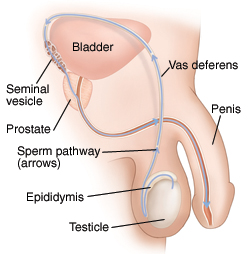Vasectomy Reversal
Vasectomy Reversal
Each of your testicles makes sperm (male reproductive cells). Sperm travel from the testicles to the penis through one of 2 tubes called the vas deferens. On the way, sperm mix with other fluids to form semen, which leaves the body during ejaculation. During a vasectomy, each vas deferens is cut, preventing sperm from leaving the body. This makes you sterile (unable to make a woman pregnant). A vasectomy can sometimes be reversed, restoring the flow of sperm out of the body.
How the procedure works
During a vasectomy reversal, the 2 cut ends of the vas deferens are stitched back together. With the sperm pathways restored, sperm can once again travel through the vas deferens and leave the body during ejaculation. You may then be able to father a child.
Preparing for the procedure
You will be given instructions to prepare for the vasectomy reversal. Tell your healthcare provider about any medicines you take, including aspirin. You may be asked to stop taking some or all of these. On the day of your procedure, bring clean cotton briefs or an athletic support with you.
During the procedure
You’ll receive medicine to keep you pain free. You may be awake and relaxed during the procedure. Or, you may be completely asleep. Once the medicine takes effect:
An incision is made in your scrotum.
The cut ends of each vas deferens are lifted out and examined. A section of each cut end may be removed.
The end closer to the testicles is cut until fluid flows freely. This fluid may be looked at under a microscope to see if sperm are present.
The 2 cut ends are stitched together. If needed, the vas may be attached directly to the epididymis (tissue behind the testicle).
When both of the vas deferens are reconnected, the incisions in the scrotum are sutured closed.
After the procedure
You may need to stay in the hospital for several hours. When it’s time to go home, have an adult family member or friend drive you. Once you’re home:
Take medicine as directed to relieve any pain.
To lessen the chance of swelling, stay off your feet as much as you can for the first day.
Place an ice pack or bag of frozen peas (wrapped in a thin towel) on your scrotum for short amounts of time. This helps reduce swelling.
Wear an athletic support or snug cotton briefs for extra support.
Follow your doctor’s instructions for showering and bathing.
Ask your doctor when it’s OK to have sex.
Avoid heavy lifting or exercise for at least 2 weeks. Ask your doctor when you can return to work.
Possible risks and complications
Risks associated with anesthesia
Infection (symptoms include fever, chills, drainage from the incision site, and pain)
Internal bleeding of the scrotum (symptoms include increasing pain, excessive swelling, a large black-and-blue area, or a growing lump)
Failure of the procedure to restore fertility
Updated:
March 20, 2017
Reviewed By:
Goode, Paula, RN, BSN, MSN,Greenstein, Marc, DO,Image reviewed by StayWell medical illustration team.
